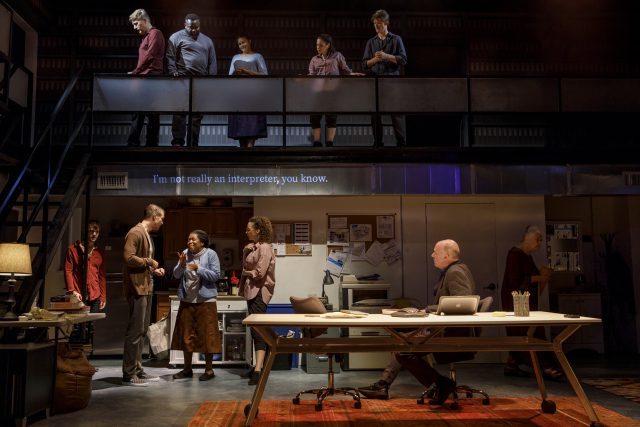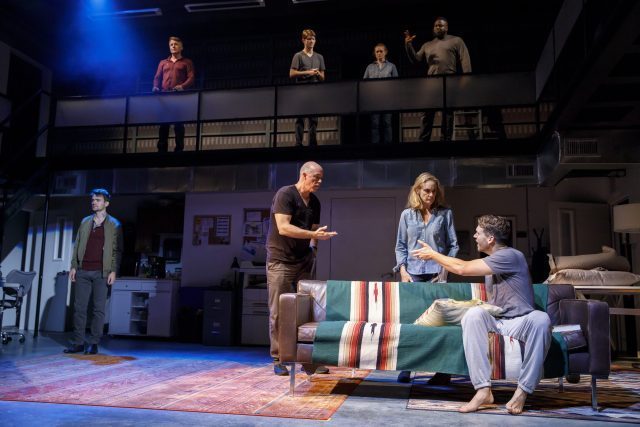
A shadow cast signs the dialogue from the balcony in Craig Lucas’s I Was Most Alive with You (photo by Joan Marcus)
Playwrights Horizons
Mainstage Theater
416 West 42nd St. between Ninth & Tenth Aves.
Tuesday – Sunday through October 14, $59-$99
www.playwrightshorizons.org
Craig Lucas’s I Was Most Alive with You serves up a Thanksgiving setting, but it’s not a genuine turkey. Rather, it’s a turducken of a play, an overwrought melodrama stuffed with everything but the kitchen sink, as troubles inside troubles inside yet more troubles pile onto the characters in this otherwise well-staged New York premiere. The show, which opened tonight at Playwrights Horizons, was inspired by real tragedies in Lucas’s life as well as the Book of Job. (Lucas also wrote the play specifically for deaf actor Russell Harvard after seeing him in the Paul Thomas Anderson film There Will Be Blood and Nina Raine’s off Broadway play Tribes.) The narrative unfolds in flashback; in California in March 2010, longtime TV writing partners Ash (Michael Gaston) and Astrid (Marianna Bassham) are trying to come up with ideas for their next collaboration, and they decide to tell the story of what happened the previous Thanksgiving, how an accident changed the lives and fortune of friends and family. A recovering alcoholic, the Jewish Ash has a strained relationship with his wife, Pleasant (Lisa Emery), who hopes he is having an affair with Astrid. Their son, Knox (Harvard), a deaf recovering alcoholic and drug addict, is in love with Farhad (Tad Cooley), an angry, hearing-impaired, drug-using Muslim. Ash’s mother, Carla (Lois Smith), a Jewish convert, has been battling cancer, attended to by Mariama (Gameela Wright), a nurse who became a Jehovah’s Witness while recovering from drug addiction and who has a son on death row. The cast is lost amid the narrative mess, overplaying underdeveloped characters we don’t care about, speaking in sermonettes and platitudes, many straight out of the recovery playbook. For example, at Thanksgiving dinner, Knox says he is grateful “for two, no, three things I used to think weren’t gifts at all: Deafness. . . . Being gay. . . . Addiction. . . . They are gifts. . . . Each brought me to great clarity.”

A family faces a series of Job-like catastrophes in I Was Most Alive with You at Playwrights Horizons (photo by Joan Marcus)
The play examines how we communicate with one another — and how we don’t — in person, electronically, verbally, and nonverbally. Most of the characters are at least partially deaf, either involving the actual ability to hear or to listen to what people are telling them, and most also have at least some knowledge of sign language. (Sabrina Dennison serves as director of artistic sign language.) Words that are signed but not spoken are projected onto Arnulfo Maldonado’s effective, if workmanlike, set. Taking a page from Michael Arden’s outstanding Broadway revival of Spring Awakening with Deaf West Theatre, in which each speaking actor was shadowed by someone signing, in I Was Most Alive with You the shadows are on the second level, shadowing their characters from above. The shadow cast consists of Beth Applebaum (Astrid), Harold Foxx (Knox), Seth Gore (Ash), Amelia Hensley (Pleasant), Christina Marie (Carla), Anthony Natale (Farhad), and Alexandria Wailes (Mariama). Unfortunately, occasionally one of the shadows emits sounds while signing, which might be inevitable but is distracting. Two-time Tony nominee Lucas (Prelude to a Kiss, The Light in the Piazza) throws in so much dizzying conflict that director Tyne Rafaeli (The Rape of the Sabine Women, Actually) never has a chance to navigate through the confusion. Not even God would have made Job suffer through I Was Most Alive with You. Playwrights Horizons’ next production is the world premiere of Larissa FastHorse’s The Thanksgiving Play; hopefully turducken will not be on the menu.